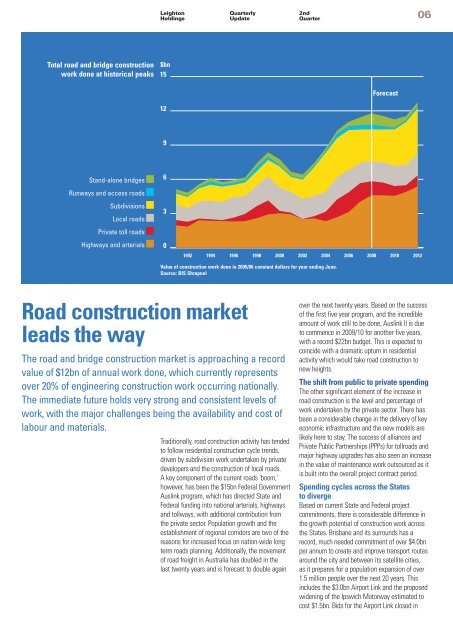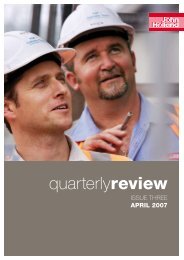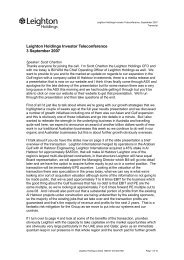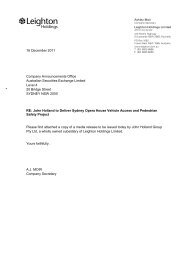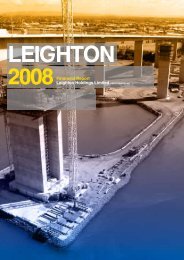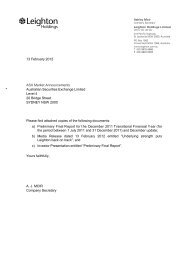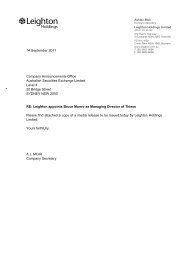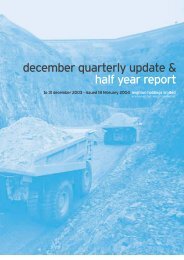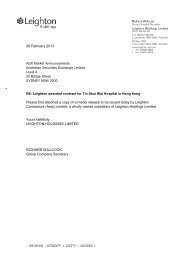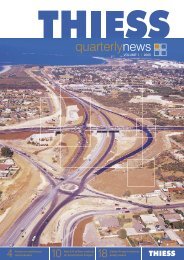PDF - 5.5 MB - Leighton Holdings
PDF - 5.5 MB - Leighton Holdings
PDF - 5.5 MB - Leighton Holdings
Create successful ePaper yourself
Turn your PDF publications into a flip-book with our unique Google optimized e-Paper software.
<strong>Leighton</strong><br />
<strong>Holdings</strong><br />
Quarterly<br />
Update<br />
2nd<br />
Quarter 06<br />
Total road and bridge construction<br />
work done at historical peaks<br />
$bn<br />
15<br />
12<br />
9<br />
Stand-alone bridges<br />
6<br />
Runways and access roads<br />
Subdivisions<br />
Local roads<br />
3<br />
Private toll roads<br />
Highways and arterials<br />
0<br />
1992<br />
1994<br />
1996<br />
1998<br />
2000<br />
2002<br />
2004<br />
2006<br />
2008<br />
2010<br />
2012<br />
Value of construction work done in 2005/06 constant dollars for year ending June.<br />
Source: BIS Shrapnel<br />
Road construction market<br />
leads the way<br />
The road and bridge construction market is approaching a record<br />
value of $12bn of annual work done, which currently represents<br />
over 20% of engineering construction work occurring nationally.<br />
The immediate future holds very strong and consistent levels of<br />
work, with the major challenges being the availability and cost of<br />
labour and materials.<br />
Traditionally, road construction activity has tended<br />
to follow residential construction cycle trends,<br />
driven by subdivision work undertaken by private<br />
developers and the construction of local roads.<br />
A key component of the current roads 'boom,'<br />
however, has been the $15bn Federal Government<br />
Auslink program, which has directed State and<br />
Federal funding into national arterials, highways<br />
and tollways, with additional contribution from<br />
the private sector. Population growth and the<br />
establishment of regional corridors are two of the<br />
reasons for increased focus on nation-wide long<br />
term roads planning. Additionally, the movement<br />
of road freight in Australia has doubled in the<br />
last twenty years and is forecast to double again<br />
over the next twenty years. Based on the success<br />
of the first five year program, and the incredible<br />
amount of work still to be done, Auslink II is due<br />
to commence in 2009/10 for another five years,<br />
with a record $22bn budget. This is expected to<br />
coincide with a dramatic upturn in residential<br />
activity which would take road construction to<br />
new heights.<br />
The shift from public to private spending<br />
The other significant element of the increase in<br />
road construction is the level and percentage of<br />
work undertaken by the private sector. There has<br />
been a considerable change in the delivery of key<br />
economic infrastructure and the new models are<br />
likely here to stay. The success of alliances and<br />
Private Public Partnerships (PPPs) for tollroads and<br />
major highway upgrades has also seen an increase<br />
in the value of maintenance work outsourced as it<br />
is built into the overall project contract period.<br />
Spending cycles across the States<br />
to diverge<br />
Based on current State and Federal project<br />
commitments, there is considerable difference in<br />
the growth potential of construction work across<br />
the States. Brisbane and its surrounds has a<br />
record, much needed commitment of over $4.0bn<br />
per annum to create and improve transport routes<br />
around the city and between its satellite cities,<br />
as it prepares for a population expansion of over<br />
1.5 million people over the next 20 years. This<br />
includes the $3.0bn Airport Link and the proposed<br />
widening of the Ipswich Motorway estimated to<br />
cost $1.5bn. Bids for the Airport Link closed in


